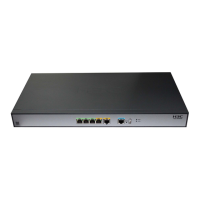852
http: Specifies HTTP packets to which the NBAR rule is applied.
tcp: Specifies TCP packets to which the NBAR rule is applied.
udp: Specifies UDP packets to which the NBAR rule is applied.
Usage guidelines
The following matrix shows the command and hardware compatibility:
MSR810/810-W/810-W-DB/810-LM/810-W-LM/810-10-PoE/810-LM
-HK/810-W-LM-HK
Yes
MSR810-LMS/810-LUS No
MSR2600-10-X1 Yes
MSR 2630 Yes
MSR3600-28/3600-51 Yes
MSR3600-28-SI/3600-51-SI No
MSR3610-X1/3610-X1-DP/3610-X1-DC/3610-X1-DP-DC Yes
MSR 3610/3620/3620-DP/3640/3660 Yes
MSR5620/5660/5680 Yes
By default, predefined NBAR rules exist, and these NBAR rules cannot be deleted or modified. If the
predefined NBAR rules cannot meet the user needs, use this command to create user-defined
NBAR rules.
A user-defined NBAR rule can contain the following match criteria:
• Destination IP subnet.
• Source IP subnet.
• Direction at which the application is recognized.
• Port number.
• Signatures. The logical relation of these signatures is OR, which indicates that a packet that
matches any signature matches the NBAR rule.
You can specify more than one match criterion for the rule. To match the NBAR rule, packets must
match all the match criteria in the rule.
Examples
# Create a user-defined NBAR rule named abc and apply the rule to HTTP packets.
<Sysname> system-view
[Sysname] nbar application abcd protocol http
[Sysname-nbar-application-abcd]
override-current
Use override-current to overwrite the current signature file for an update operation if the APR
signature database is automatically updated at a regular basis.
Use undo port-mapping to restore the default.
Syntax
override-current
undo override-current

